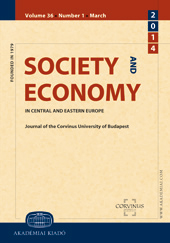Some Aspects of European Economic Area and Competitiveness
Some Aspects of European Economic Area and Competitiveness
Author(s): András BlahóSubject(s): Economy, Supranational / Global Economy, International relations/trade, EU-Accession / EU-DEvelopment
Published by: Akadémiai Kiadó
Keywords: international co-operation; economic policy; European Union; convergence; cohesion; competitiveness; trade theories;
Summary/Abstract: With eight former socialist economies joining the European Union, the European Economic Area underwent substantial change. Integration co-operation, mostly through the usage of structural funds requests partners on lower level of development to catch-up (converge) to the average level of development of the Community. Williamson (1965) had shown first that indeed, there is a convergence measured on national level, the price for which, however, is a growing differentiation among the regions. Suggested way of achieving cohesion is the catching-up of less developed regions and nations. When productivity or difference in GDP per capita is taken as the most important indicator for cohesion then catching-up could be achieved by a higher than average European Union GDP per capita growth in the catching-up economies. Hence, economic growth is the key to cohesion. Trade-off theories suggest that the most important trend in international economic co-operation is the hypothetical b (beta) convergence. Convergence depends on economic policy, created competitive advantages. These factors request thorough analysis of various aspects of competitiveness: setting proper ratio between overall and regional development, achieving high-level efficiency in state administration, supporting research and development, enhancing education on all levels, and last but not least, putting in place a well-functioning economic regulation and industrial policy. Concrete challenges for the Hungarian institutional system, regulation and international cooperation are also dealt with related to the above.
Journal: Society and Economy. In Central and Eastern Europe ǀ Journal of the Corvinus University of Budapest
- Issue Year: 27/2005
- Issue No: 1
- Page Range: 63-90
- Page Count: 28
- Language: English

